FROM LISBON TO CASCAIS: WHAT TO SEE, DO AND EAT ALONG THE ESTORIL COASTLINE
You might have not heard about Estoril yet, but you have certainly heard about Bond… James Bond! The character also known as 007 was created by British writer Ian Fleming, who was a British naval officer serving in Portugal during World War II. As during those hectic times Portugal was one of the very few neutral countries in western Europe, it soon became a popular destination amongst spies. Fleming spent a lot of time at Palácio Estoril Hotel (Rua Particular). And it was here, and at the nearby Casino Estoril (Av. Dr. Stanley Ho), that he met the man he later claimed to have inspired the popular secret agent.
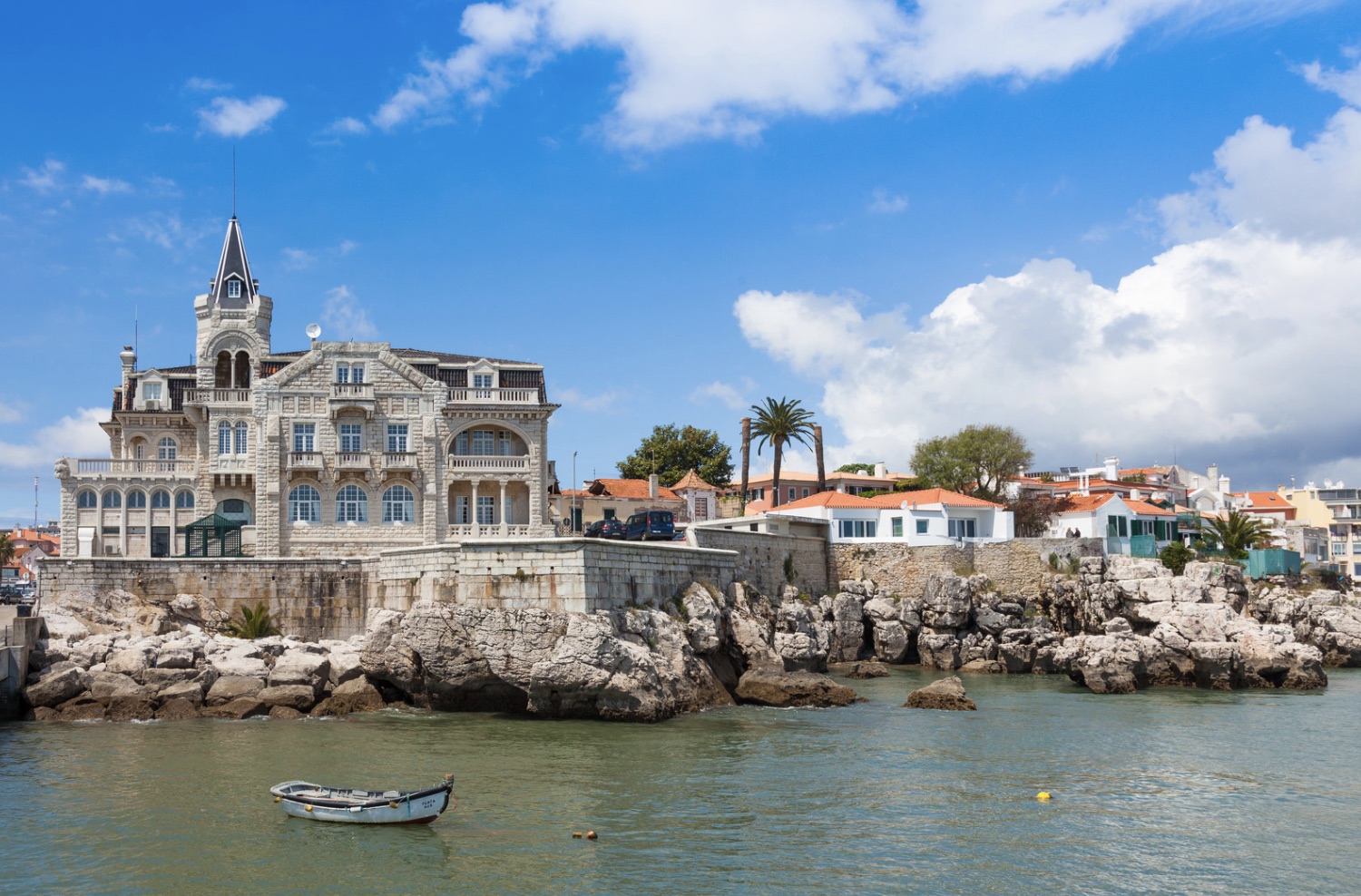
Cascais village
Curious about the charms of Estoril and Estoril’s coast now? Let’s dig deeper…
The area between Lisbon and Cascais (the so-called Linha de Cascais, literally the Cascais line), passing by the Estoril Coastline, is often also referred to as the Portuguese Riviera. We could somehow compare it to Cannes in France, or Marbella in Spain. Which means that this is an area mostly inhabited by wealthy people, and sought after by the rich and the famous for vacationing amongst their own elite peers.
As you embark on the trip by train from Lisbon to Cascais you may not feel at first that this is a luxurious destination. While the trip offers gorgeous vistas towards the Atlantic (and that is indeed a luxury when you’re paying a regular public transportation ticket), the first towns you’ll pass by are mostly residential and home to the middle class. But get further and further away from Lisbon and the scent in the air will suddenly feel like a mix of salty ocean breeze and Chanel No. 5.
The Cascais Line: more than a train line, a way of life
Literally speaking, Linha de Cascais stands for the train line that goes from Cais do Sodré station in downtown Lisbon, to the heart of Cascais. But everyone around Lisbon knows that, if you say you live along this line or are da linha, many folks will be ready to jump to conclusions about your role in society, your background and, even if it’s unfair, even your likings. It is like this now and it’s been this way since at least the 70s.
The Portuguese book “Filhos da Costa do Sol” by Manuel Arouca is an iconic piece of literature that very well describes the spirit of this area neary Lisbon back in the decade of great romantic ideals, during the carnation revolution which finally brought down the fascist regime and instituted democracy in Portugal. This was a time when tight society rules were finally relaxing just enough for teenagers to start living according to their values, with experimentation, surfing and drugs in the mix. That was life near Estoril beach back in the day and that was one of Silvia’s (Oh! My Cod founder) bedside books when she was 16 years old.
Today, most Portuguese will associate folks from Cascais and Estoril with fancy families and we even have a slang term to refer to these individuals. The word beto or betinho is the complete opposite of chav. Not necessarily someone from the aristocracy, but fairly fancy. To give you an idea, if we had to place the Spice Girls around the geography of the greater Lisbon area, Posh and David Beckham would definitely be investing in some real estate near Estoril. We’re not here to endorse this over simplistic way of organizing individuals according to wealth or social status, but if we’re to give you real context about Cascais and Estoril, then this information certainly becomes relevant.
Besides being a home to well off families, particularly multi generational, as real estate in this area is not only pricey but also hard to come by, Cascais and Estoril are popular vacation spots but also day-trip destinations for those staying in and around Lisbon, particularly looking to spend the day at the beach.
In recent years, especially in the past decade, the area has also become one of the preferred areas for retirees and expats to settle in. Cascais and Estoril have become highly desirable by the international community, for the obvious beach related charms that justify the area being promoted as a resort destination, but also because there’s great nature besides the ocean nearby, and all urban amenities one would need for a comfortable life (shops, restaurants, specialized stores, international schools, etc) abound.
Living along the Estoril Coastline is certainly not within everyone’s reach – as in, it is indeed for the rich! But that doesn’t mean you can’t visit for the day and make the most of your time exploring the area. After all, Cascais is within super easy reach from Lisbon and we’re about to equip you with some great local tips which will help you make the most of your day-trip!
The train from Lisbon to Cascais
The train which takes you from Cais do Sodré station in Lisbon, right across the street from the popular food hall Time Out Market, to the center of Cascais, offers a delightful trip. There are ocean views included indeed but, remember, when you depart from Lisbon and travel parallel to the water this is actually the Tagus river, known in Portuguese as Tejo. It is only a few kilometers ahead where the river mouth starts connecting with the Atlantic ocean and the views become even more expansive and breathtaking.
The distance from Lisbon to Cascais is about 30 Km (around 19 miles) and while you could drive here via the A5 highway or, better yet, the waterfront road, taking the train is easy and affordable, and the service conveniently runs between 5:30 AM and 1:30 AM. Furthermore, the actual train stops almost work as a sort of itinerary, marking most places worth stopping at – to go to the beach, for a nice stroll and, of course, to go eat out too!
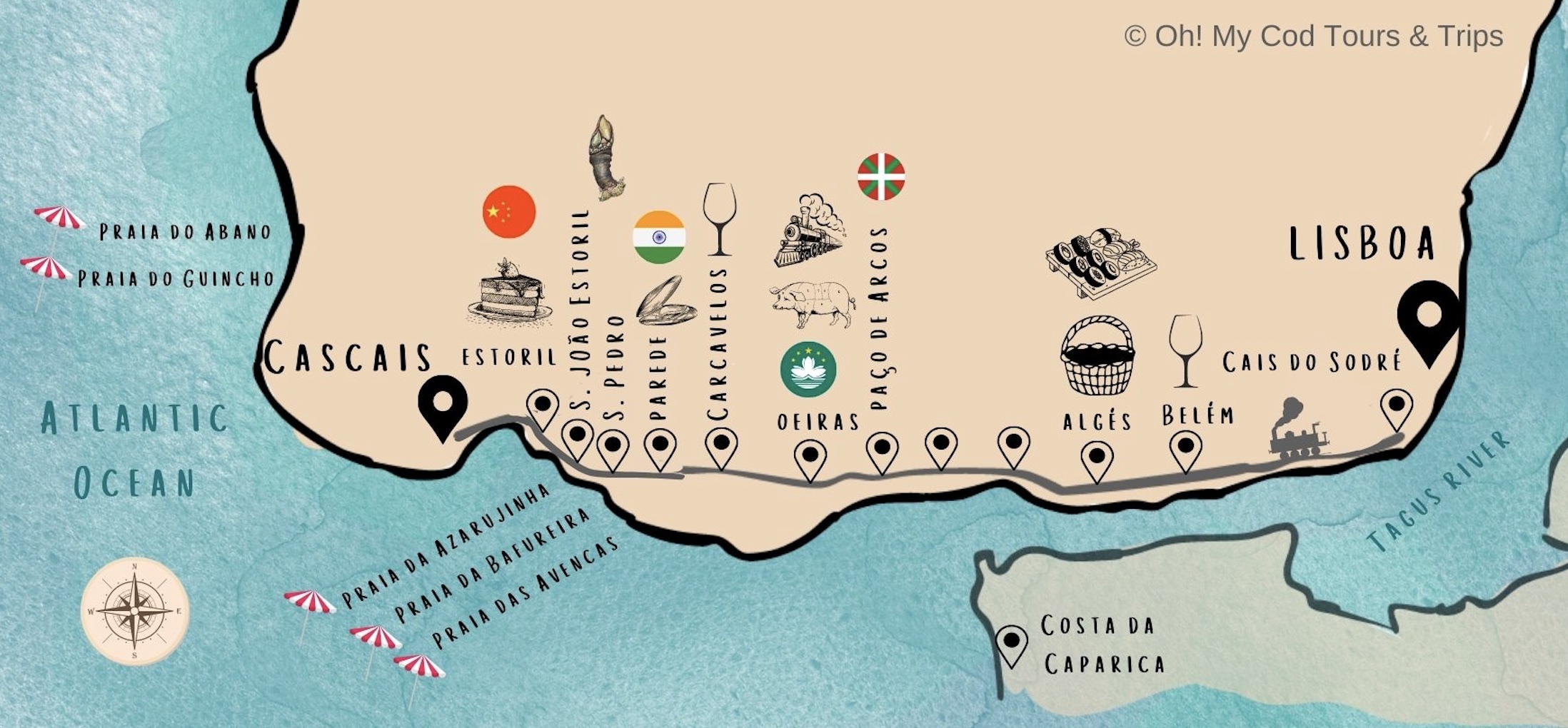
Our favorite beaches along the Estoril Coastline
The several beaches you’ll find along the Estoril Coastline aren’t exactly unknown. After all, this area is within very easy reach from Lisbon and there are lots of residents from Estoril itself, Cascais and the surrounding areas who come here to enjoy leisure time by the sea.
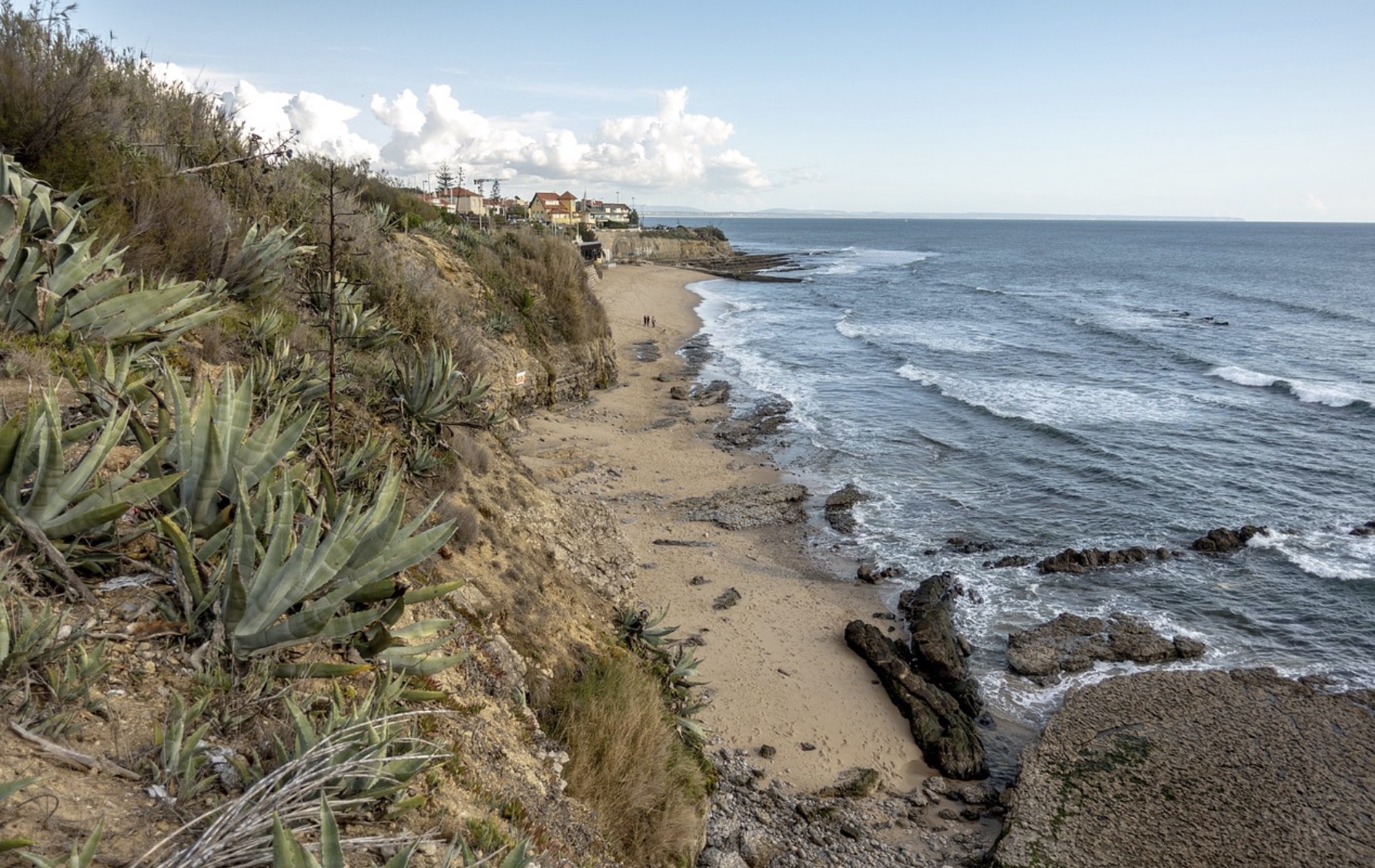
Avencas beach
We could be talking about Carcavelos beach, for example, but the truth is that most people will come to know about this one the moment they read anything about the area or simply hop on the train to Cascais – lots of folks come out in the Carcavelos train stop. Following Carcavelos’ popularity you’ll probably find beaches such as Torre, Parede and São Pedro do Estoril, and even Praia da Rainha within proper Cascais itself.
Instead, we’d like to suggest other beach spots which we can’t accurately label as hidden gems but that tend to have something unique going about them. In geographical order coming from Lisbon towards Cascais, our favorite beaches along the coast of Estoril include:
Praia das Avencas
If you don’t care about water sports and would rather enjoy a more pristine kind of scenery, this is the beach for you! As Avencas is considered a protected maritime area, there are motosports nowhere near here, which means reduced noise and lesser pollution.
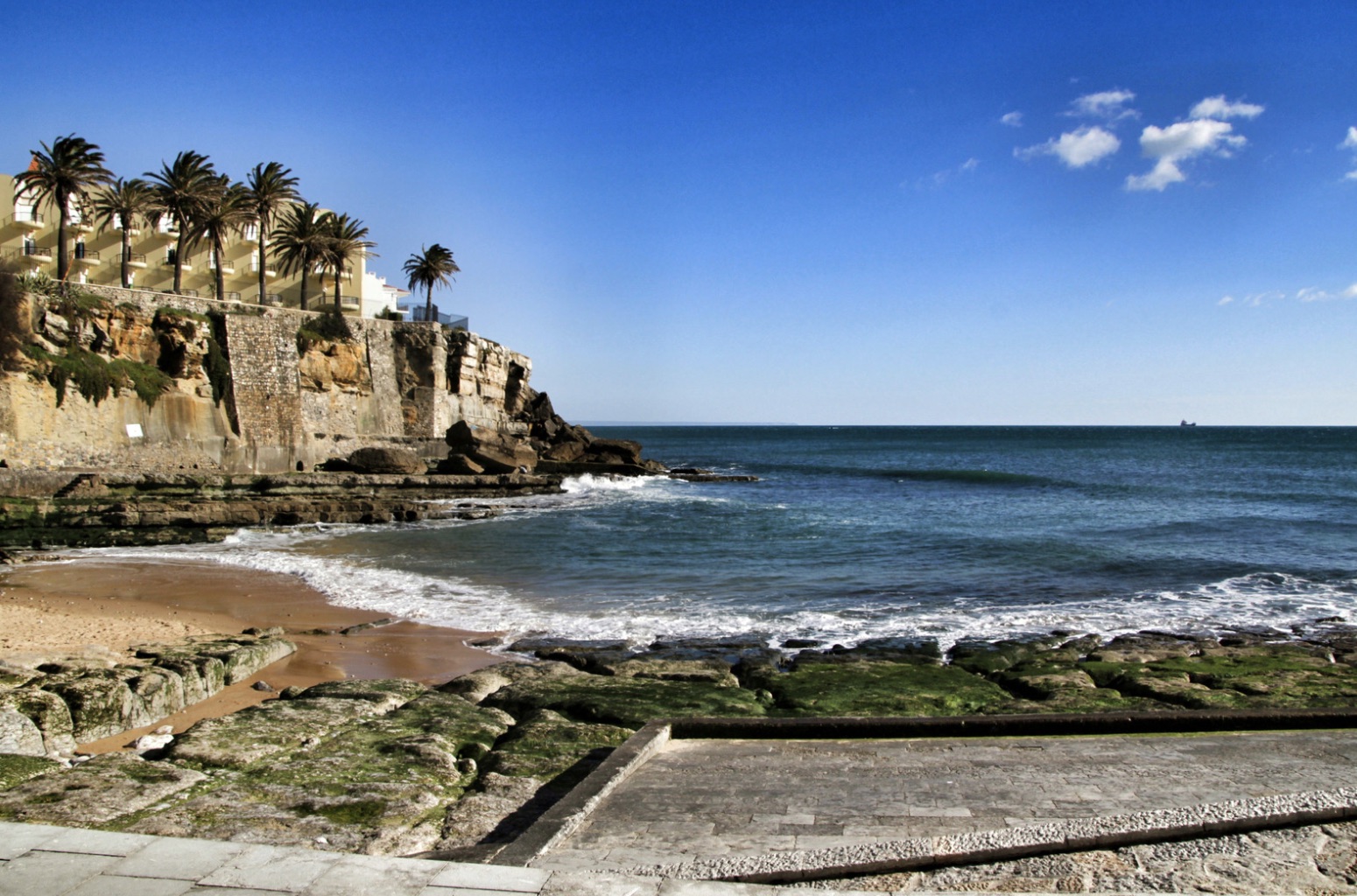
Azarujinha beach
If you are exploring the area with kids, it can be a good idea to visit the natural pools at Avenca beach. These are natural swimming holes that come about as the tide rises and there’s sea water which accumulates in between the rocks. Even if you don’t have kids, it’s such a great feeling to take a dip and lounge in here. Around these rocks there are over 100 different underwater species, which nature loves will certainly care for. You can always grab a drink at the local beach bar and try to spot crabs, starfish, octopi and more. It can be so much fun to stop for a moment to appreciate the wonders of nature, particularly considering that, in Portugal, there is only one other underwater protected area, which is located in Arrábida Natural Park. [inserir aqui link p/ artigo sobre Setúbal]
Praia da Bafureira
The rugged cliffs all around make lots of beach goers stay away from Bafureira beach and choose other more popular options nearby. That seems kind of silly to us but, on the other hand, tha means more space for us and other folks who actually appreciate the more natural and untamed look and vibe of this beach.
But don’t be mistaken as this is a beach right next to “civilization” and, exactly overlooking the cliffs and the waterfront, you even have the Bafureira Club (Av. Marginal, Parede), a restaurant and events venue that serves out-of-this-world sushi!
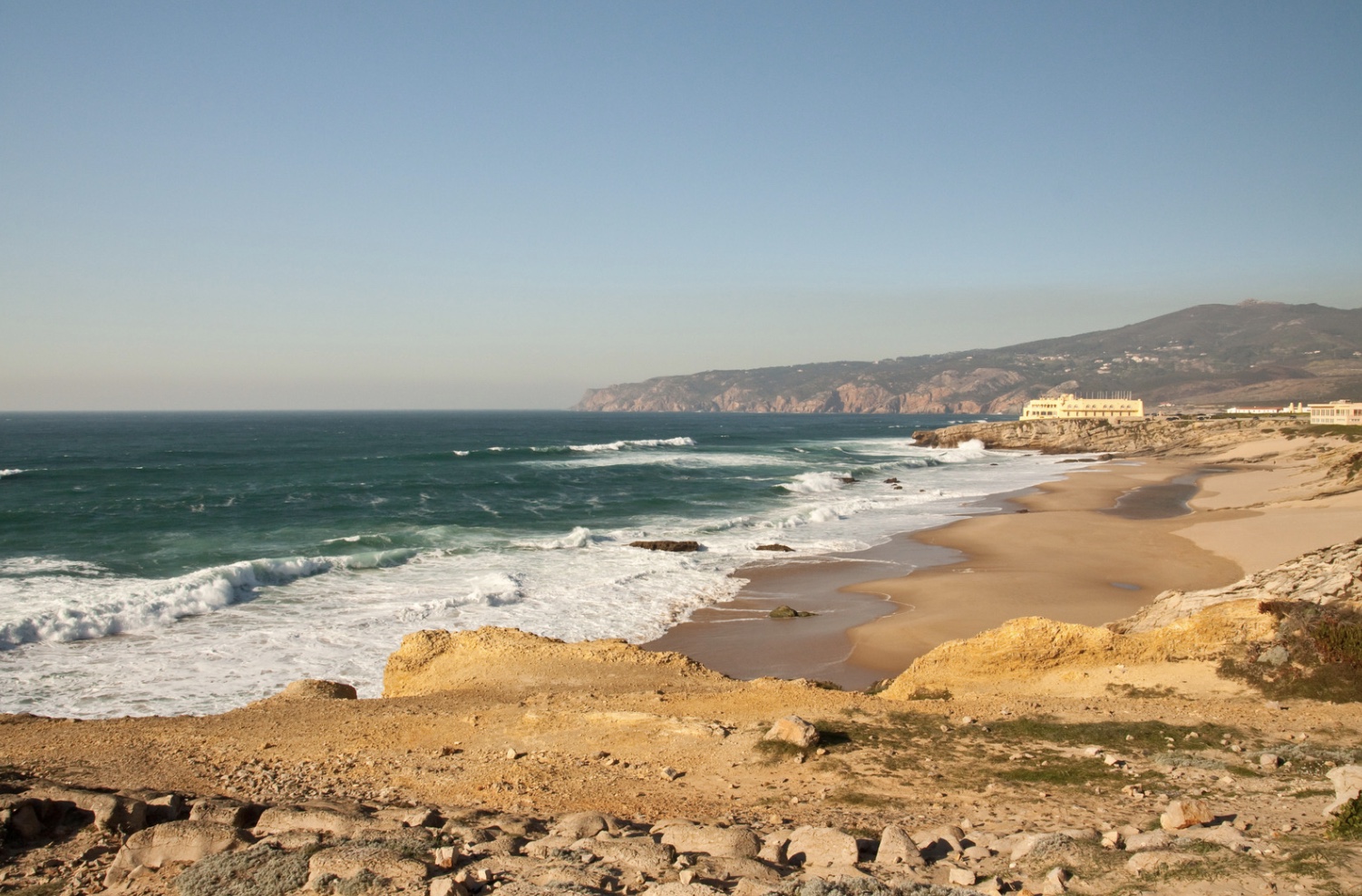
Guincho beach
Praia da Azarujinha
This is the tiniest beach in Estoril (also, the hardest beach to spell!) and exactly where Cascais’ boardwalk begins. It’s the perfect spot to start a walk and go explore the other beaches in the area on foot. If the term “hidden gem” was to be used to describe any beach in this area, Azarujinha beach would be it!
There’s usually nearly no one around as this mini beach sits in a kind of bay which seems like a pocket between worlds. Even if you go to a larger beach in Estoril, the moment things get crowded and overwhelming, you can always pop in here for your own private little world. Praia da Azarujinha is almost like a natural amphitheater between the cliffs, and even though it seems a little wild, you can very conveniently get there by coming down the stairs which connect to São João do Estoril’s train station.
Praia do Guincho
We can’t say that we’ve discovered a secret spot when we’re talking about Guincho beach, but it’s still one of our favorites in the area. This (in)famously windy beach is located 5 Km (3 miles) past Cascais, on the western edge of the Sintra-Cascais Natural Park. Because it’s within a protected area, Gincho beach stays safe and away from over tourism and developments which could ruin its natural beauty.
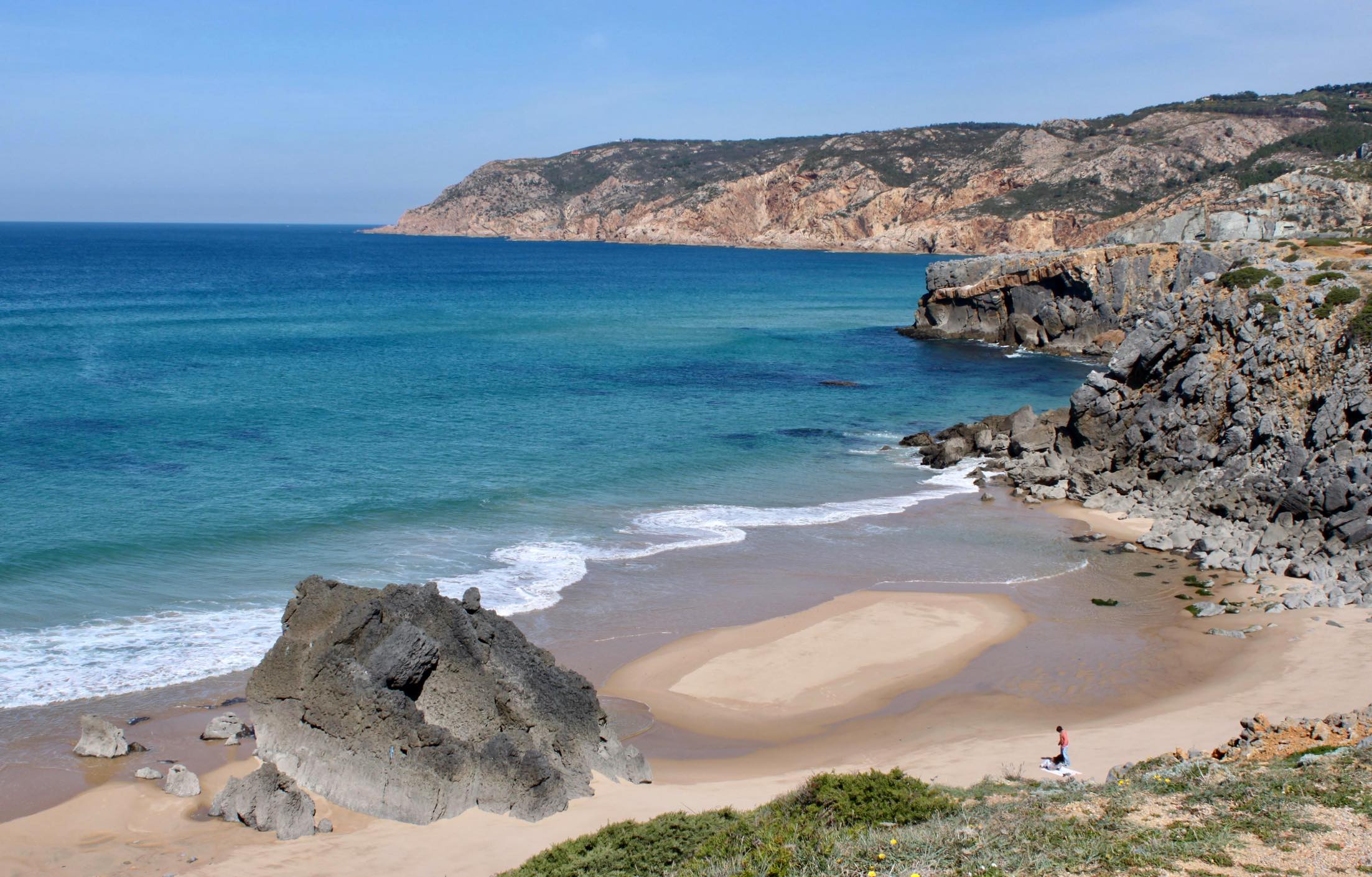
Abano beach (© Câmara Municipal de Cascais)
Because of its mega breezy natural conditions, Guincho is the beach of choice for those into wind related sports, such as windsurfing. The wind which helps agitate the ocean makes it ideal for surfing too, but it may not be the best choice of a beach for sunbathing, unless you don’t mind eating sand as an appetizer.
Guincho is a good destination for sightseeing followed by a stunning fresh fish or seafood meal – see our tips below for the best to eat spots to go eat in Guincho beach (such as Bar do Guincho which hosts four different concepts, including a casual beach bar and thee restaurants), including a Michelin starred restaurant!
Praia do Abano
Also belonging to Cascais, we find Abano beach, in the locality of Alcabideche. It is basically an extension of Guincho beach, a sort of smaller sister with similar weather conditions and white powdery sand… which unfortunately tends to fly and get inside your eyes on the roughest days.
Still, we love Praia do Abano, if nothing else, because it’s a beautiful untouched spot for a walk, connecting with your natural surroundings.
And also because, just like with Guincho above, there are eateries nearby that truly do stand out!
What to do in between Lisbon and Cascais, besides the beach
Cascais and the Estoril Coastline as a whole may be known mostly as a beach destination, but that doesn’t mean that this is the only thing that’s worth exploring around here.
Of course you could take advantage of this sunny corner of Portugal as a gastronomic destination, and that in itself would be a great plan. But you could also come here to, for example, visit boutiques with one of a kind products, such as a Cabinet of Curiosities (Av. de Nice 68), Cura (Av. Sabóia 915C), or the refined Espace Canelle (Rua das Arcadas do Parque 52H).

© Confraria do Vinho de Carcavelos
Carcavelos wine
If we had to pick just one thing to do between Estoril and Cascais, we would choose exploring the marvelous world of Carcavelos wine. This is one of Portugal’s four fortified wines, alongside Madeira, Moscatel and the uber popular Port wine from the Douro Valley.
Carcavelos wine is grown in one of the smallest demarcated regions in the word, which has been under tremendous pressure since the 20th century, because of urban development that started eating into the areas which once upon a time were vineyards. In recent years, thanks to a public program meant to preserve the tradition, Carcavelos is making a comeback, but we know that it is still little known amongst tourists and, if we’re honest, even within our country itself.
As Carcavelos wine is produced in the sub-region of Carcavelos in Oeiras, we would suggest for you to go straight to the source to taste this indulgent sweet wine, which is produced with Portuguese grape varietals such as Arinto, Boal, Galego Dourado, Negra Mole, Ratinho, Trincadeira and Torneiro.
To learn more about Carcavelos wine and do a wine tasting, you can visit the winery of Villa Oeiras (Adega Casal da Manteiga Rua da Mina, Estação Agronómica Nacional, Oeiras), the store by Confraria dos Enófilos do Vinho de Carcavelos (Rua Cândido dos Reis 49), or a wine bar such as Castiço (Praça Dr. Manuel Rebello de Andrade 3).
Best restaurants along the Estoril Coastline
There are way too many worthwhile eateries along the 30 Km (approximately 19 miles) or so that separate Lisbon and Cascais. For restaurant recommendations within Cascais itself, please see our tips below. Here we aim to highlight some of the places we would go to eat out along the coastline, as well as more inland, as Estoril’s good food doesn’t certainly just concentrate near the beach.

© Kanazawa restaurant
Where to go eat out in Algés
Mercado de Algés (Rua Dr. Manuel de Arriaga) is to Algés what Time Out Market is to Lisbon – a gourmet food hall which provides a fun setting to try local dishes from different eateries. During the morning it operates as a regular fresh produce market and, during the rest of the day, it’s a hub for cuisine and entertainment, trying to stay true to the filmy slogan “comer, beber, amar”, that is, to eat, drink and love.
Algés is super close to Lisbon, just past the popular monument district of Belém and, let us tell you, it is a dining destination with so much to offer! We would start by highlighting Kanazawa (Rua Damião de Góis 3 A), which serves a kaiseki menu, that is, a Japanese style tasting menu which closely follows and respects the seasons and only uses ingredients when they are at their peak of freshness and flavor. Their set menus aren’t the kind of indulgence us mere mortals go for on a daily basis, but we certainly like to treat ourselves coming here every so often, and we love that we can do so with vegetarian friends, as they also have a vegetable kaiseki option.
If you prefer Portuguese style food, O Relento (Av. Combatentes da Grande Guerra 10C) has been a highly praised seafood restaurant for over 50 years. Besides incredibly fresh sea creatures, they serve irresistible fried snacks while you wait for your meal – you must try their meat croquetes, prawn rissoles and Portuguese style samosas, which are different than the ones we explore during our food tours in Mouraria but, interestingly enough, are connected because of Portugal’s history with its ex colonies.
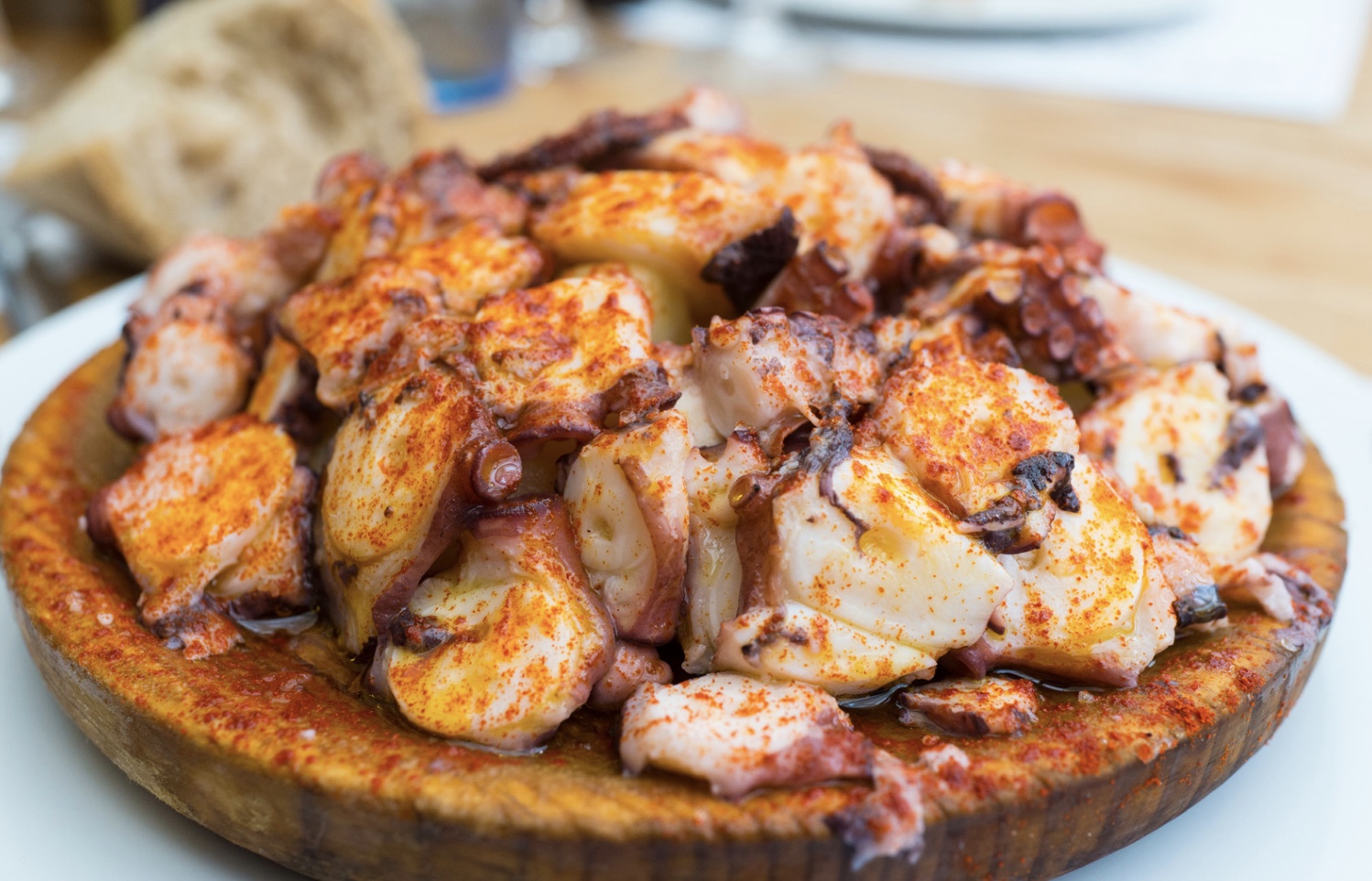
Galician style octopus
And because not everything has to be grilled fish just because you are close to the beach (that’s what often ends up happening across Portugal) head to Sé da Guarda (Rua Sport Algés e Dafundo 16) to munch on all sorts of fried fish, from fish filets with loose coriander flavored rice, to tiny sardines and mackerel which you can even snack on with your hands as you chat with fellow customers about the latest football match.
Recommended restaurants in Paço de Arcos
Os Arcos (Rua Costa Pinto 47) opened its doors back in 1967 and it’s the kind of establishment where families from around Paço de Arcos would go for a gathering involving great traditional Portuguese food. Their specialties include an intensely flavored hare rice and stewed partridge with chestnuts and potatoes. Comfort food which, as you can see, supports our argument that this coastline has more to offer than “just” beaches and seafood.
Casa Galega (Rua Costa Pinto 126) is a nod at our neighbors from across the border, as it serves typical food from the Spanish regions of Galicia and the Basque Country. You can certainly have a Spanish style tortilla with eggs and potatoes, but you could also try Galician style octopus with smoked paprika, or the fried hake Basque style – a real treat!
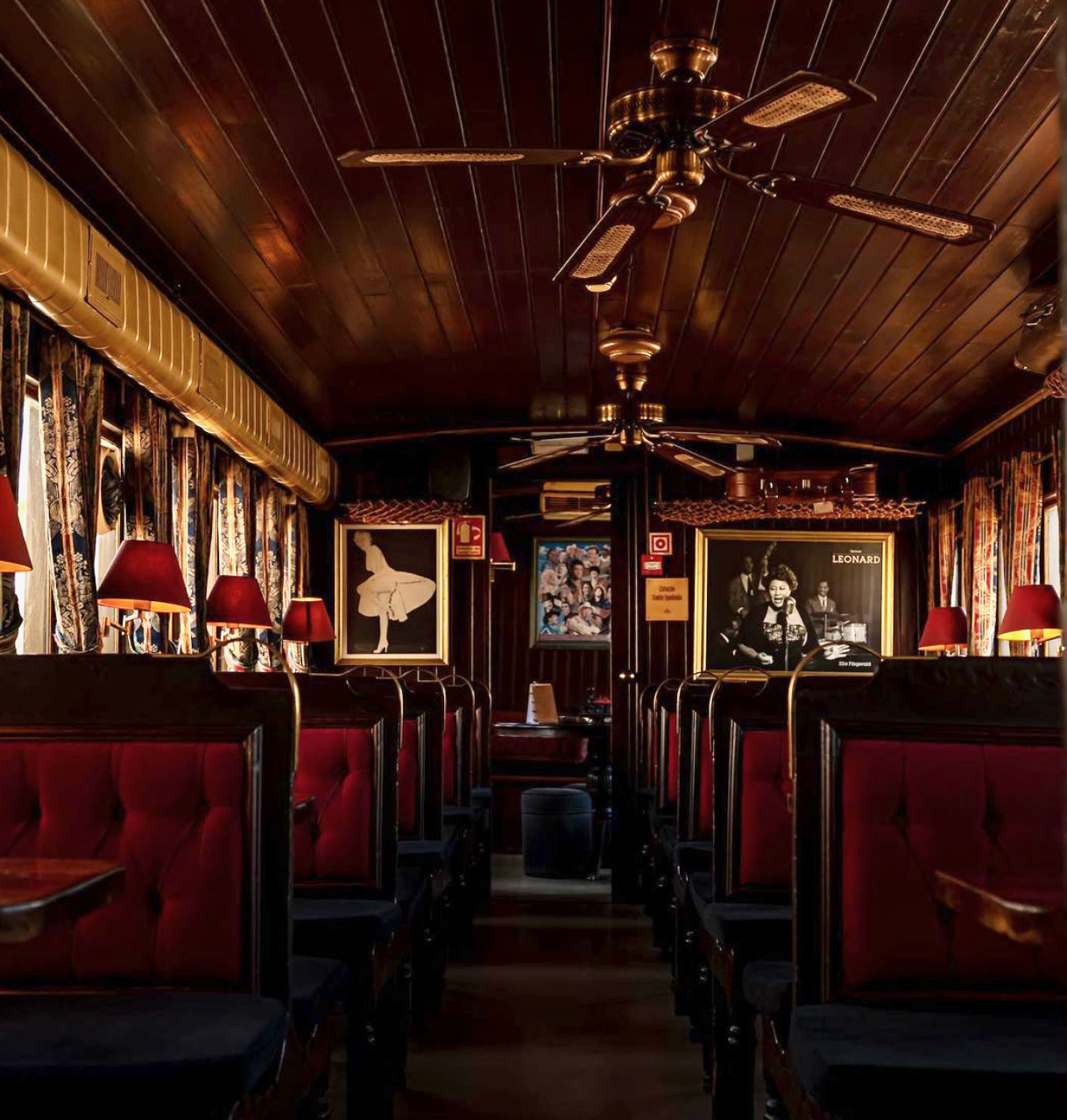
© Luar da Barra Carruagem Bar
For Portuguese food that hits the spot at more than fair prices, make Marítima de Paço de Arcos (Rua Costa Pinto 57) one of the most popular restaurants in Paço de Arcos. Their breaded and deep fried pout fish with açorda, a savory pudding which originally came about from the need to repurpose stale bread back in the day, is as simple as it is satisfying. We sincerely wished there were more places like Marítima de Paço de Arcos in Lisbon, or at least that the ones that are already there didn’t keep disappearing with the increased gentrification.
Tips to go eat out in Oeiras
Oeiras has a lot going for it when it comes to eating out! We could start highlighting Zé Varunca (Av. Eng. Bonneville Franco 22A), the closest to authentic regional cuisine from the Alentejo which you get around here, or Macau Dim Sum (Praceta Maputo 6), for authentic specialities from China which are considerably more affordable than at Estoril Mandarin (see below the Estoril section).
Once again, do not forsaken Carcavelos wine when in the area. Alongside other gourmet goods, this sweet fortified wine can be purchased at Villa Mercearia Moderna (Rua Dr. José da Cunha n.º 30 B) in Oeiras.
Fancy a different kind of restaurant experience in Oeiras? Vist Luar da Barra Carruagem Bar (Parque Da Torre-Passeio Marítimo), a pretty cool cafe and simple eatery set up inside an old train wagon, which also includes a terrace by the beach.
Not to eat per se, but to learn more about the process behind olive oil extraction, you can visit the Lagar do Azeite inside the Marquês de Pombal Palace (Largo Marquês Pombal 21), where the artifacts on display and accompanying explanations are bound to increase your appreciation for Portugal’s “liquid gold”.
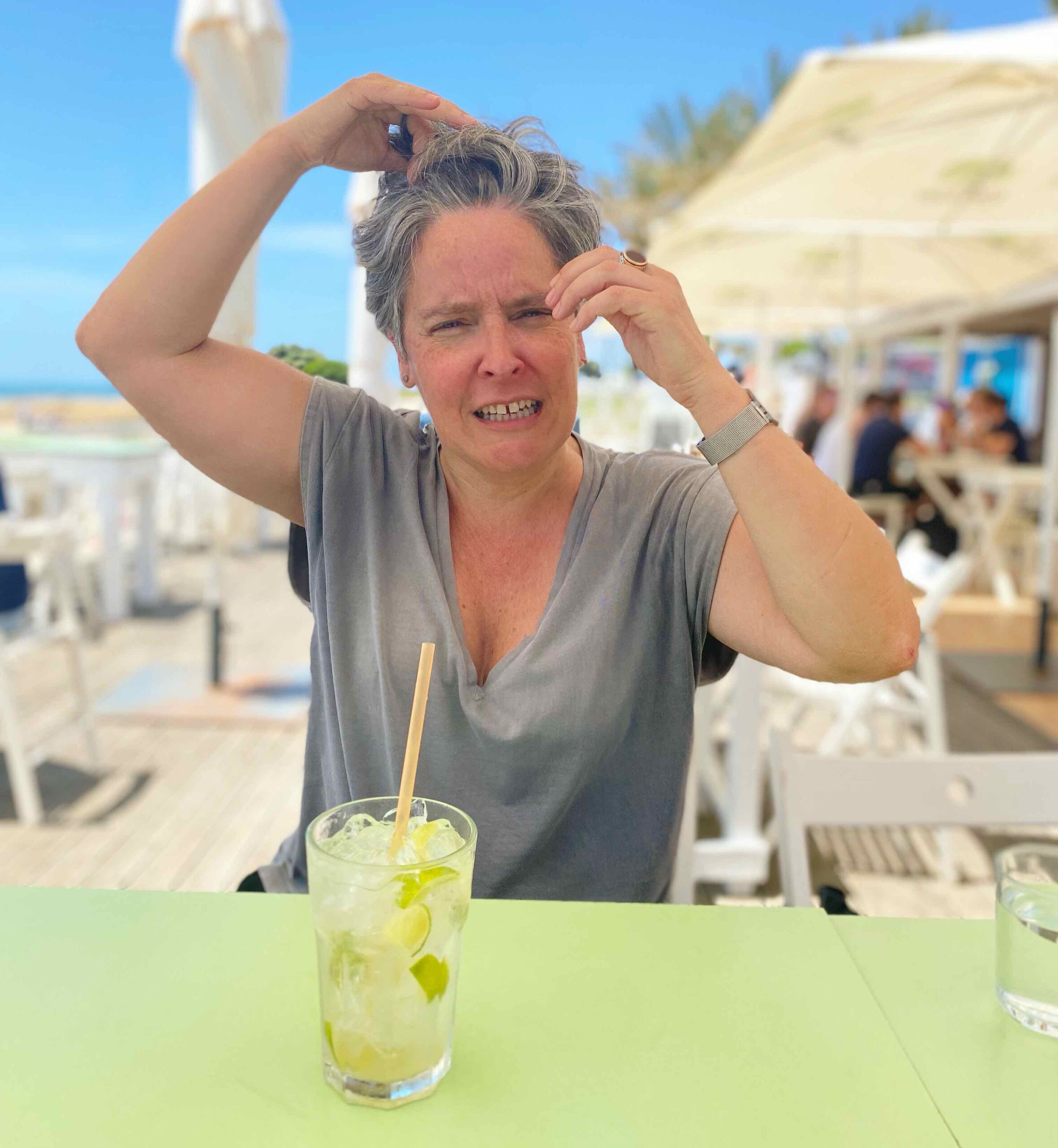
Moinho Bar (© Adriana Schmidt)
Where to eat in Carcavelos
If Carcavelos is where many of us would head to for the sake of spending time at the beach, you can’t ignore Bar dos Gémeos (Av. Marginal), a simple bar with such good vibes, where you can forget about time with a drink in hand. If Gémeos gets too busy, but that is rarely the case, Moinho Bar, one minute’s distance is also a good option to lounge around. Sílvia loves the caipiroskas they made, as we can see!
As Carcavelos is one of the most touristic spots in the Estoril Coastline, eateries can be more hit or miss. Between so-so pizza and overpriced supposedly healthy waps, you can always count on Taverna do Rogério (Estr. Rebelva 633A) for a good meal in Carcavelos – they serve fresh fish like most restaurants in the area, but their salt cod dishes are also impeccably executed and very representative of the repertoire of Portuguese cuisine.
Great eateries in Parede
To act as a palate cleanser in between one fish meal too many, here in Paredes we would like to recommend African food at Kaia Kahina (Praceta Lagoa de Óbidos 85A). This is a beautiful spot to explore the intersections between the cuisines of Portugal and some of its ex-colonies, namely Goa (in India) and Mozambique, in Africa. This translates into gory but delicious sarapatel and xacuti, which are dishes from the Indo-Portuguese cuisine repertoire (at some point in history also exported to Mozambique), several curries, and so much more!
Eduardo das Conquilhas (Rua Cap. Leitão 118) is a must stop in Parede to precisely eat conquilhas, quick is Portuguese for cockles, but also other species of shellfish and bivalves, as well as summer favorite caracóis, that is, braised snails.
For a quick coffee break (and pastry, of course – this is Portugal, after all!) we recommend Pastelaria Ribeiro (Av. da República 1317), hands down, the best address for coffee and all things sweet in Parede.
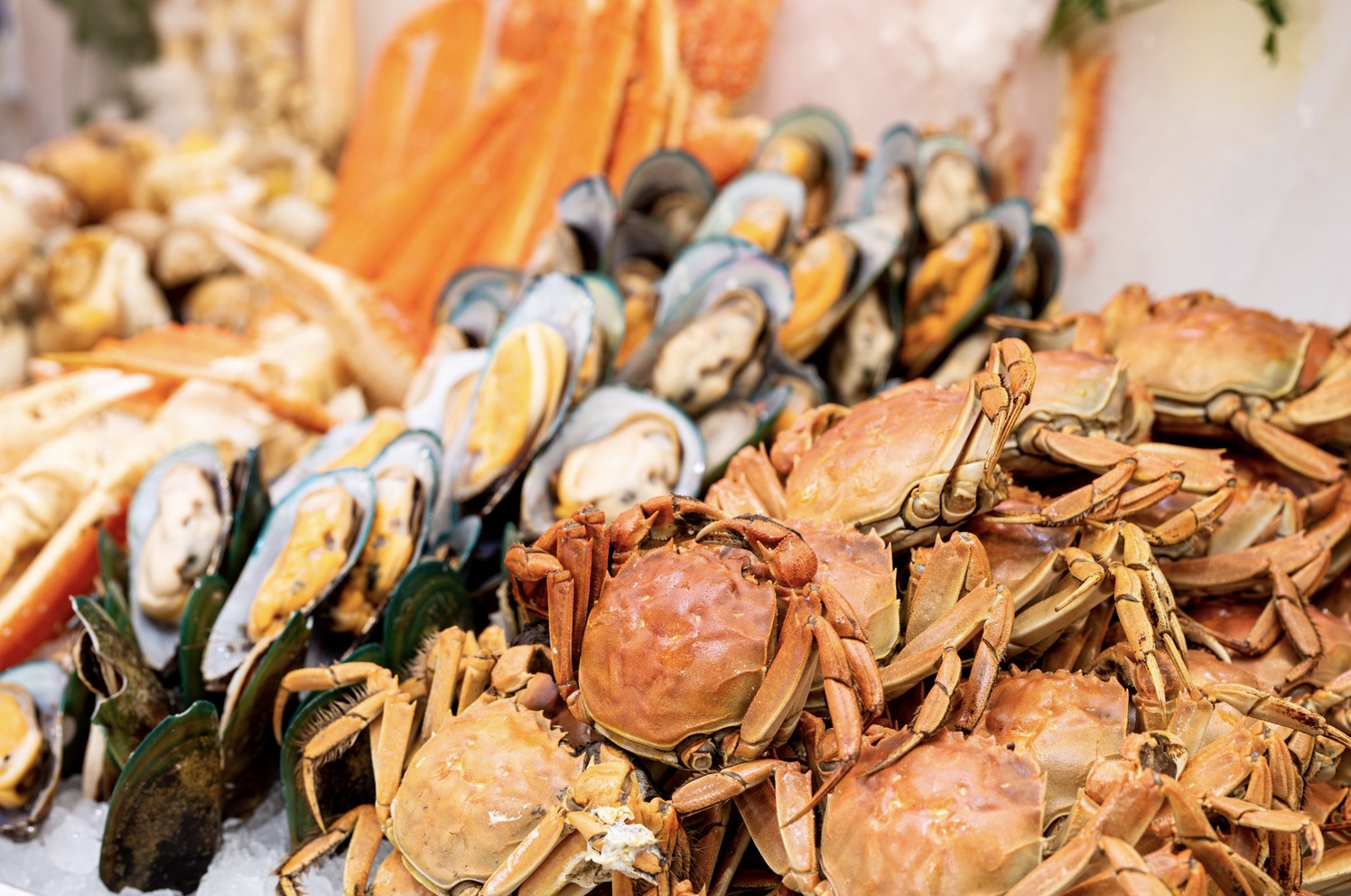
Some of the delicacies you can have at Eduardo das Conquilhas
Where to have an incredible gastronomic experience around São Pedro and São João do Estoril
São Pedro do Estoril and São João do Estoril are not to be mistaken with Estoril because, even though all of these localities neighbor each other, they are officially different places.
In São Pedro, Boteco da Linha (Rua Sacadura Cabral 116) serves proper Portuguese petiscos (aka small plates, tapas style) and traditional dishes, as well as some lighter bites such as burgers, which go well with the beach vibes which are often felt around here. If you’d like to sample the freshest goose barnacles (known locally as percebes) here they serve them literally from the sea to your plate!
In Sao João do Estoril we’re partial to Flor de São João (Praceta Gil Vicente) where you can have well executed fish and meat grills, or the kind of dishes which are bound to make us happy on a Sunday lunch, such as saucy seafood rice (arroz de marisco).
Dining experiences in Estoril
When we do a trip to Estoril, you bet we start the day with a sweet breakfast at Pastelaria Garrett (Av. de Nice 54). This cafe and pastry shop is an institution of all things Portuguese and sweet, with a decidedly elegant touch. This is a cool spot not only for coffee and pastries, but also for people watching, Estoril style.
When it comes to having lunch, you can go the traditional route and head to Bolina (on the boardwalk between Tamariz beach and Poça Beach) or O Sinaleiro (Av. Sabóia 595), for down to earth honest Portuguese food. You could also go medium fancy and head to Jackpot (Rua Lisboa 1A) for a restaurant that feels a little like a time capsule but, at least when it comes to cooking, that’s in this case a good thing. Or you can splurge and head to Estoril Mandarin (Casino Estoril, Av. Dr. Stanley Ho) which has gathered a reputation, amongst other high praises, of having the very best dim sum in all of Portugal.
Itinerary for a day-trip to Cascais
Once you have crossed the several stops that make up the Estoril Coastline you would generally reach Cascais. Even if for some reason you don’t allocate enough time to stop along the Cascais line, going straight to Cascais would still be worth it. Taking the train to Cascais means a quick and picturesque trip of just about 40 minutes or so – timings here!
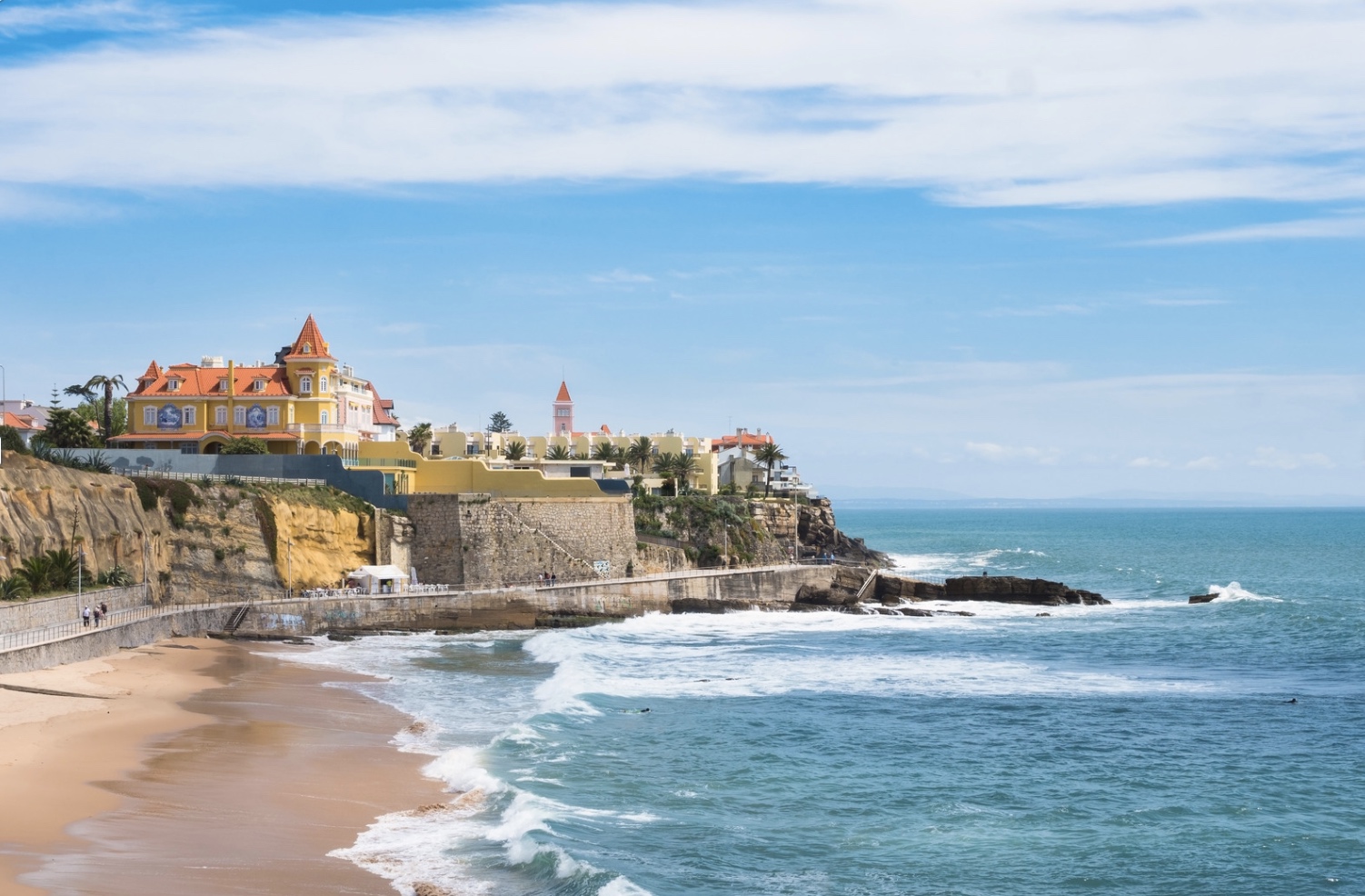 Cascais’ train station is located right at the heart of this coastal city and, from here, you can easily walk to the beach or go explore the center of the town. As soon as you step out of the train station, you’ll notice how the vibe is quite different than in Lisbon. Much more relaxed even when busy, the air smells of vacation… even when you come here just for a day trip!
Cascais’ train station is located right at the heart of this coastal city and, from here, you can easily walk to the beach or go explore the center of the town. As soon as you step out of the train station, you’ll notice how the vibe is quite different than in Lisbon. Much more relaxed even when busy, the air smells of vacation… even when you come here just for a day trip!
What to see and do in Cascais
Once in Cascais there’s always the option of going with the flow. After all, the town is pretty, people are friendly, there’s plenty of cafes which invite you to lounge around with a cup of coffee in hand… but, if you want to make the most of the time you’ve got in this lovely city, we have some great tips for you.
Of course what you end up choosing to see and do will have to do with your preferences, but enjoying the ocean one way or another is a must for those who make the effort to come here! If you like keeping active, we would certainly recommend renting a city bike, which you can easily do via the MobiCascais system. There are cycling lanes connecting the town all the way to Guincho beach. On the way there, and even if you don’t make it to Guincho, don’t overlook Boca do Inferno (Av. Rei Humberto II de Itália 642). This “hell’s mouth” is a chasm in the seaside cliffs, where the ocean waves hit the shore rocks with tremendous strength, and is thus a remarkable spot from where to appreciate the power of the ocean, the force of nature and, through it all, take a little pause to think about our place in the world.
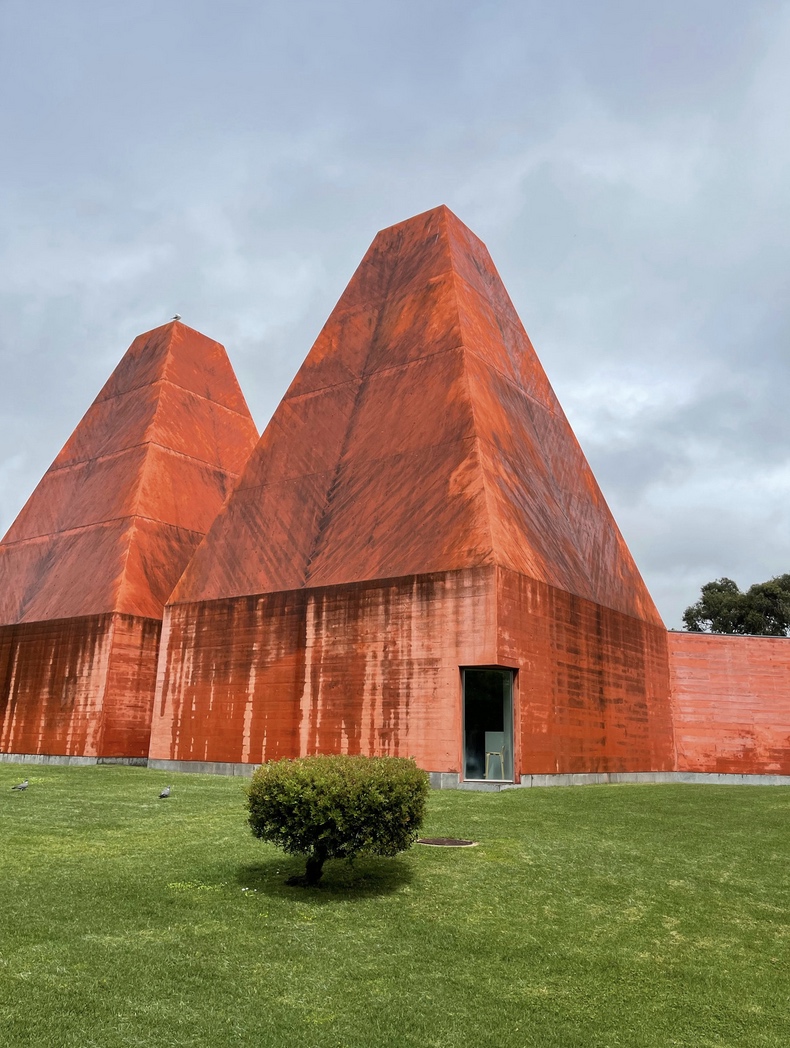
Casa das Histórias Paula Rego
If two wheels aren’t your thing, know that Cascais is extremely walkable. The area known as paredão in Portuguese is a walkway parallel to the ocean and the beach areas. If you are traveling with kids and are a bit weary of the open sea, check out Piscina Oceânica Alberto Romano (Av. Marginal 1), a natural pool ideal for a more protected dip. If the weather isn’t the best for soaking in the pool, take your little ones to OHficina – Laboratório de Materiais Improváveis (Parque Marechal Carmona), an amazing workshop which focuses on art, education and environmental sustainability – their weekend activities on a “laboratory of unlikely materials” will surely keep them engaged!
Artististic vibes are plentiful in Cascais too. After all, this may be a resort town but it’s also a place where plenty of people live. It’s not one of those summer destinations which becomes a ghost town in the winter – not at all! At Casa das Histórias Paula Rego, for example, you’ll be able to appreciate a collection of the artwork by Portuguese-British visual artist Paula Rego, who was one of the most iconic contemporary artists in our country, mostly known for her paintings and prints based on storybooks (we love her! If you wish, go further watch the documentary recently made by his son. Unadmissable!). If you prefer appreciating a more urban kind of artwork, which happens at the intersection between crafts and social movements, we recommend strolling around Bairro da Torre, a hip neighborhood between Moinho and Torre beaches. Here you’ll find eye-catching examples of street art, such as more than twenty huge murals covering building facades, which resulted from the urban art festival Muraliza. In Bairro da Torre, just as in other spots of Cascais, there are al fresco cafes and bars a little all over the place. But that doesn’t mean everything’s fashionable around here.
For a feel of times gone by you could pop over Drogaria Costa (Rua Visc. Luz 12A), one of the oldest grocery stores in Portugal! This family-run business has been open for 130 years and, while buying a new mop might not be a top priority when you visit Cascais, taking a sneak peek at such a peculiar establishment can be fun!
To understand the close relationship Cascais has historically had with the sea (and before we even get to talk about seafood), allow us to suggest a stop by Museu do Mar Rei D. Carlos. This museum dives deep into the history of the local fishing communities, the maritime heritage of Cascais, and the fascinating social and economic realities that could be observed over the years in this area.
Because talking about Cascais is synonymous with talking about fish and seafood, a stop by Mercado da Vila (Rua Padre Moisés da Silva 290) is mandatory for those into food and food culture. This is Cascais’ municipal fresh food market, a vibrant place of business which has been bringing together under one roof fresh produce, seafood and more every since 1952. Once upon a time super traditional, Mercado da VIla is still the place to go for some of the best seafood in Cascais, but they are also keeping up with the times, namely through a busy and varied program which focuses on different food related activities. From cooking demonstrations, to hands-on workshops and themed events, there’s always something interesting going on at Cascais’ market, under the umbrella of Cascais FoodLab – check their schedule of activities here.
Best restaurants in Cascais
As Cascais population is very significantly made of expats from different nationalities, you can easily expect that the restaurant scene is quite international too. For example, you’ll find pretty authentic Indian restaurants, like Natraj (Rua São Carlos 109) or Ghandi Palace (Rua Frederico Arouca 39), and even Chutnify (Rua Afonso Sanches 53) for genuine food in a rather hipster setting. As a general rule of thumb in Portugal, the best Indian restaurants away from the most obvious urban areas tend to concentrate in parts of the county where there’s a sizable British community, case in point, the Algarve region down south!
Italian restaurants in Cascais are also common, and some of our favorites include De Benedictis (Rua Frederico Arouca 35), a small but inviting place which can easily make you feel like traveling there next (or take you back if you are lucky to have already been there!); and Lambrettazzurra Pizzeria (Tv. Visc. da Luz 3) for seriously good pizza.
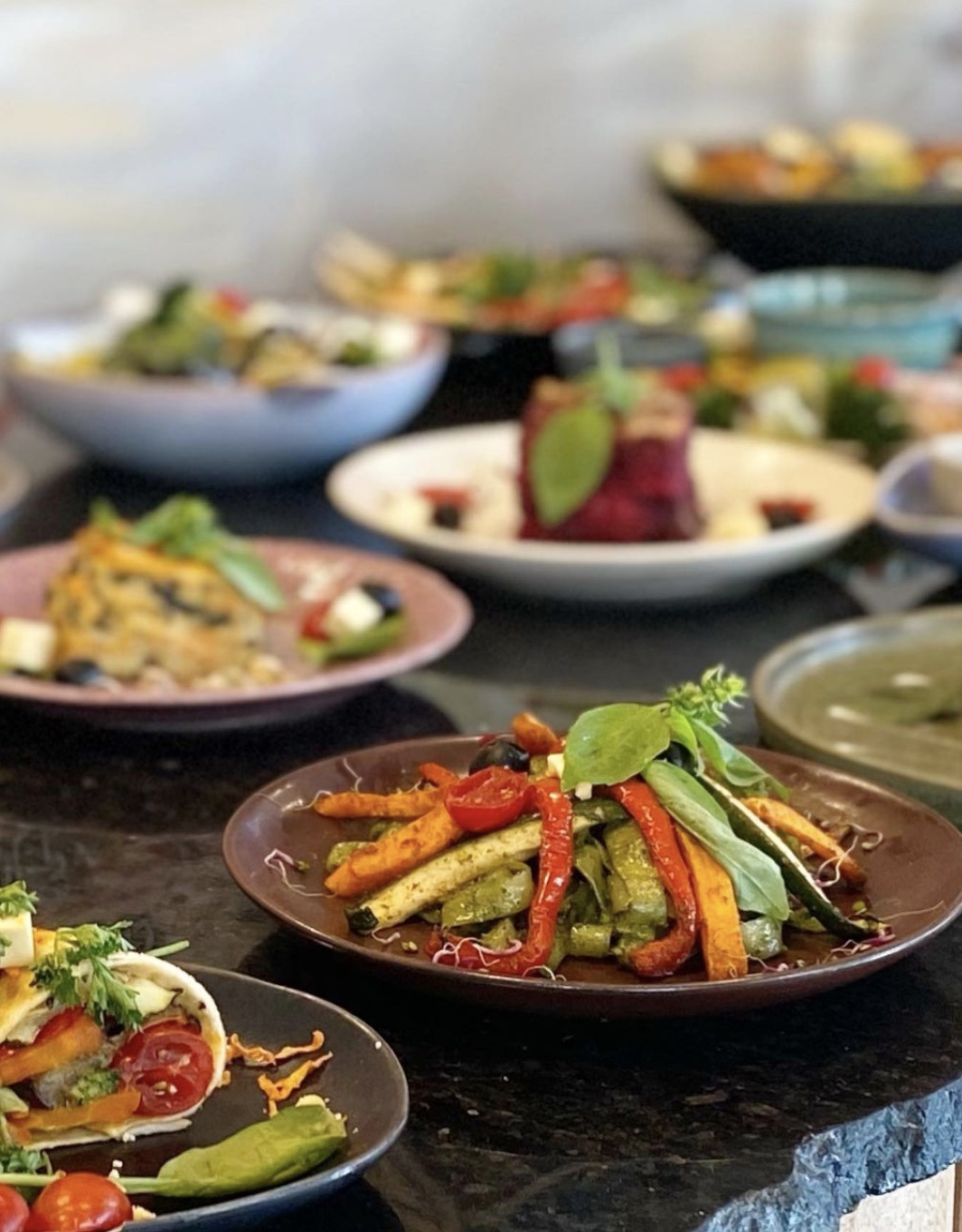
Once you enter House of Wonders color will invade your retina and palate
Considering the proximity to the sea and the abundance of fresh seafood, just like it happens in Lisbon, there’s very good sushi in and around Cascais! The fact that there’s purchasing power around here also contributes to offerings which focus on outstanding quality, and examples of that can be tasted at Japanese restaurants in Cascais such as KAPPO (Av. Emídio Navarro 23 A), Confraria (Rua Luís Xavier Palmeirim 14), or the cool Moa Sushi (Tv. das Oliveiras 131). If your budget allows, definitely check out the Japanese Bar at The Oitavos hotel (Rua de Oitavos), where you can do an omakase tasting menu where the chef will do the “hard work” of choosing for you.
Those following a vegetarian or vegan diet won’t have any trouble finding plant-based options around Cascais. House of Wonders (Rua da Misericórdia 53) is one of the most celebrated vegetarian restaurants in Cascais, as it serves a super fresh rotating lunch special, which can still leave some room for the decadent works of art that are the vegan donuts from Scoop ‘n Dough (Rua Frederico Arouca 298), where plant milk based ice-creams are also a hit!
Focusing on traditional Portuguese food in Cascais, we’d like to start by recommending a couple of pastelarias, the typical Portuguese establishments which act as a hybrid between cafes, pastry shops and, sometimes, even humble eateries during lunch time. Centenary Bijou de Cascais (Rua Regimento 19 de Infantaria 55) is the kind of place you want to go to for breakfast or for an espresso and a pastel de nata as a pick-me-up in the mid afternoon, but also for people watching! If you have already had your fill of custard tarts in Lisbon (is that even a thing?) go for something more typically cascalense. I, a small biscuit which literally translates as sands, as they remind us of the shoreline once crushed, are a classic, and so are the nozes de Cascais, or Cascais nuts, a moist little cake with a sugary walnut as a topping.
In the sea of options that is Cascais dining scene, of course there are plenty of worthwhile typically Portuguese options. In fact, while you are traveling in Portugal, it’s certainly not compulsory to only eat local food, but we’d be the kind of people who’d pretty proudly encourage you to try as much as possible, including food which would normally be out of your comfort zone. If you need contextualization and someone to curate the best for you, this is what our slow food tours in Lisbon are all about!
Rua Amarela, officially Rua Afonso Sanches 44, is the name of a street in Cascais that is more like a gastronomic hub. It is around here that every year, towards the end of the summer season, Cascais hosts an event called Todos para a Rua! (meaning “let’s go out on the streets, everyone!”) to promote the eateries in and around Rua Amarela. Indeed this is a street packed with restaurants and cafes and, if you’re not sure where you’d like to eat out in Cascais, simply come here, walk around, browse the options, and something will certainly catch your eye. Our favorite eateries in Cascais’ yellow street include Taberna Clandestina, Dom Diniz and Dona Francisca, serving meals great for sharing; COAL for high quality grilled meats; and Senhor Manuel, a top notch seafood bar.
Some of the eateries that stand out the most in Cascais are indeed fish and seafood restaurants. As elsewhere in Portugal, the freshest catch of the day is best enjoyed presented in simple preparations, such as grilled over charcoal, with sides of potatoes and veggies drizzled with olive oil. Good options to sample Portuguese style grilled fish in Cascais include Baía do Peixe (Av. Dom Carlos I 6) for an all-you-can-eat fish buffet; Beira Mar (Rua das Flores 6), one of the oldest and still running seafood restaurants in Cascais; and Marisco na Praça, a classic that doesn’t disappoint, with one address at the Mercado da Vila, Cascais municipal market (Rua Padre Moisés da Silva 34), and another one by the marina (Marina de Cascais, 1st floor).
If you’d like to pamper yourself with a more elaborate and varied seafood meal and you’re not looking at prices, go to Mar do Inferno (Av. Rei Humberto II de Itália), consistently rated as one of the finest fish and seafood restaurants in Cascais.
Fortaleza do Guincho (Estrada do Guincho 2413) is a one Michelin star restaurant near the beach at the same name, where chef Gil Fernandes delights diners with dishes that celebrate the bounty of the Atlantic ocean. Brilliant food aside, the set up is lovely with expansive views towards the ocean – watching the sun go down here as your palate experiences a gastronomic kind of dawn, is one of the most exciting food experiences you can enjoy near Cascais!
For Asian haute cuisine, Estoril Mandarin serves incredible Chinese meals (see above), while Midori (Quinta da Lagoa Azul – technically Sintra, but within the Cascais-Sintra Natural Park), headed by Portuguese chef Pedro Almeida, serves remarkable Japanese recipes that have Portuguese influences.
For Portuguese food with a twist, you can also visit Hífen (Av. Dom Carlos I 48), a self-declared “hotspot” by the trendy Cascais’ bay. Their cooking style relies on creative and out of the box takes which are able to transform Portuguese classics which could be easily found elsewhere, and turn them into exciting new dishes which are easy to like, as they still do have a familiar taste after all.
If you only have one day to explore the area between Lisbon and Cascais, without forgetting Costa do Estoril, don’t miss:
- Enjoy the scenic train ride of the Cascais line which goes right by the sea
- If you are into wine, certainly don’t skip Villa Oeiras in Carcavelos, where you can sip Portugal’s best kept fortified secret
- During high season, skip Carcavelos and head to the quieter Praia da Azarujinha for a relaxing time at the beach
- Feel like riding some waves or at least try to? There are tons of surfing schools which can guide you in and around Carcavelos (Boogie Chicks is an ultra cool bodyboarding school just for girls!)
- Once in Cascais, stroll around the old town, visit the local market and don’t forget to recharge your energies indulging in some sweet areias
- Feel like being active? Ride a bike between Boca do Inferno and Guincho beach, or simply go for a stroll along the 3 Km of Paredão de Cascais which connects Conceição and Azarujinha beaches
- As the night goes down, do your best James Bond impression trying your luck at Casino Estoril. If luck is on your side, go spend the night at Palácio Estoril Hotel or try the many restaurants we recommend above
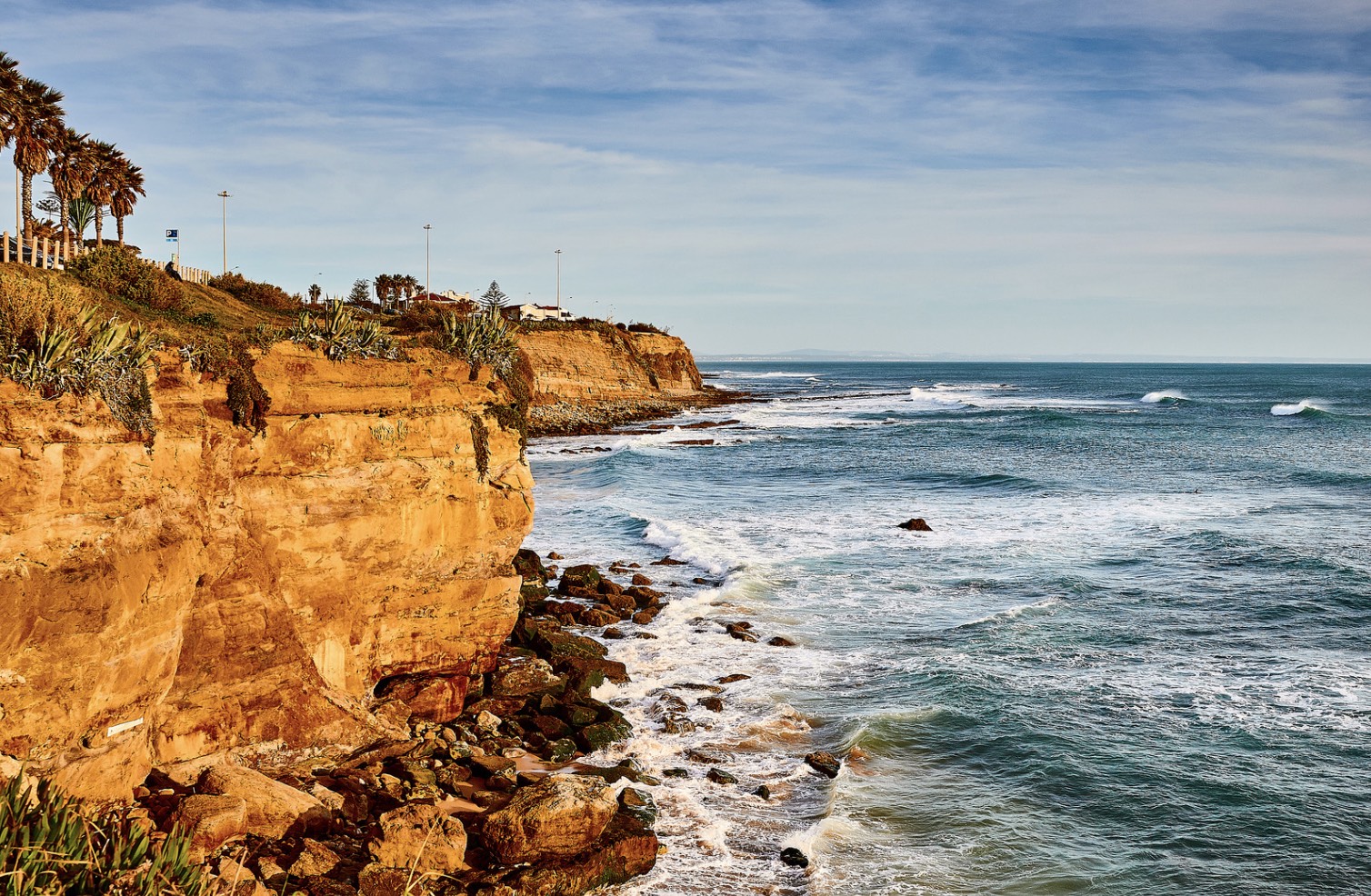
Estoril, also called the golden coast, we can easily understand why.
Article by :
Zara Quiroga (freelance food writer and food & cultural leader at Oh! My Cod Pico Trips)
Sílvia Olivença (anthropologist and food guide/CEO at Oh! My Cod Ethnographic Food Tours & Trips)
Photos by:
Sílvia Olivença (anthropologist and food guide/CEO at Oh! My Cod Ethnographic Food Tours & Trips)
Want to more about Portuguese cuisine and its influences?
Fish (r)Evolution: from the Roman times to contemporary Portuguese Chefs
A day trip to Setúbal from Lisbon filled with history, sea culture and incredible cuisine
How Portugal influenced Indian cuisine
Alentejo and Algarve: culinary traditions of the South of Portugal
Alternative beaches near Lisbon and where to eat and drink nearby
